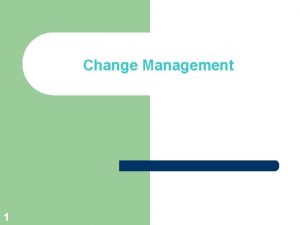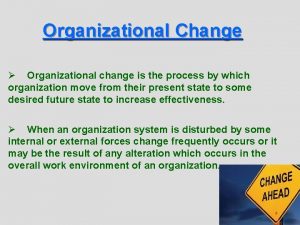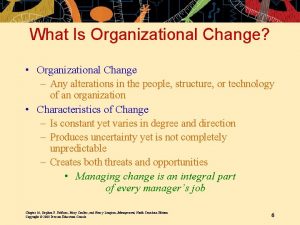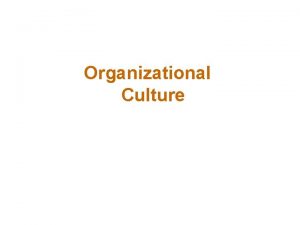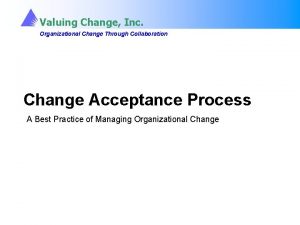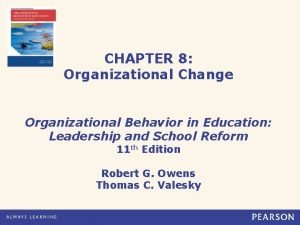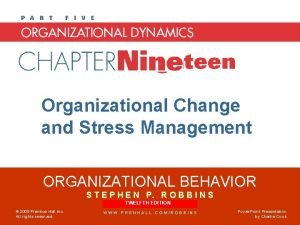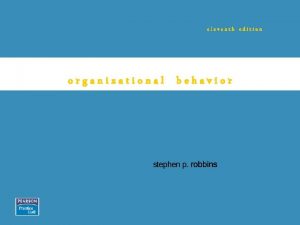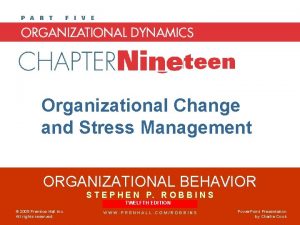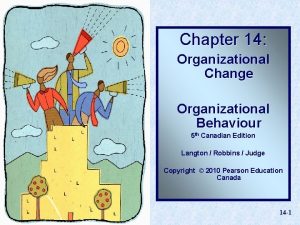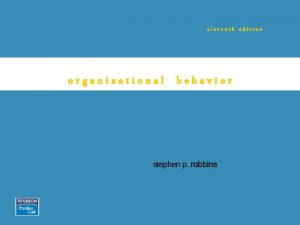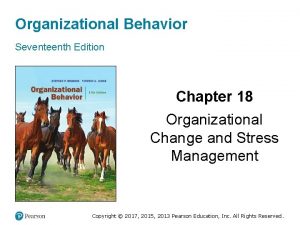Organizational Change What is Organizational Change v The























- Slides: 23

Organizational Change

What is Organizational Change? v The process by which organizations move from their present state to some desired future state to increase their effectiveness

Workforce World Politics Social Trends Forces For Change Competition Technology Economic Shocks

General Model of Planned Change Entering and Contracting Diagnosing Planning and Implementing Evaluating and Institutionalizing

Different Types of Planned Change v Type of Change Evolutionary n Revolutionary n v Magnitude of Change Incremental n Quantum n v What impact would these different types of changes have on any change initiative?

Managing Planned Change Evolutionary Change Revolutionary Change Gradual Rapid Incremental Dramatic Narrowly-focused Broadly-focused

Instruments of Change Evolutionary Change Revolutionary Change Socio-tech systems Re-engineering TQM Restructuring Empowered work grps Innovation

Lewin’s Change Model Unfreezing Changing Refreezing Lewin’s Three-Step Process

Lewin’s Change Model Unfreezing - involves encouraging individuals to discard old behaviors by shaking up the equilibrium state that maintains the status quo Moving - new attitudes, values, and behaviors are substituted for old ones Refreezing - involves the establishment of new attitudes, values, and behaviors as the new status quo

Lewin’s Force-Field Theory of Change v Theory of change which argues that two sets of opposing forces within an organization determine how change will take place Forces for change and forces making organizations resistant to change n To change an organization, managers must increase forces for change and decrease forces resisting change n

Unfreezing the Status Quo Desired State Restraining Forces Status Quo Driving Forces Time

Force Field Analysis Driving forces Resisting forces New equipment Group norms for output Familiar equipment Competition Complacency Employees with new skills Need to learn new skills Desire for higher rewards Fear of reduced rewards High perf. goals Current level of group performance Desired level of group performance

Resistance Forces Change & Resistance Forces Strong No Change Discontinuous Change Weak Sporadic Change Continuous Change Weak Strong Change Forces

Resistance to Change - Individual Selective Information Processing Force of Habit Individual Fear of the Unknown Economic Factors Need for Security

Resistance to Change-Organisation Threat to Existing Relationships Group Inertia Structural Inertia Organizational Threat to Existing Allocations Threat to Expertise Limited Focus of Change

Employee Readiness for Change High Low High readiness Moderate to indeterminate readiness Low Level of Dissatisfaction with the Current Situation Perceived Personal Risk from Change Moderate to indeterminate readiness Low readiness

Overcoming Resistance to Change Education and Communication Participation Negotiation Facilitation and Support Manipulation and Cooptation Coercion

Managing Change: It’s Culture Bound! • Does culture influence change? • Does culture influence resistance? • Does culture influence implementation? • Does culture influence idea champions / change agents ?

Requirements for Successfully Changing Organizational Culture v Understand the old culture first. v Support employees and teams who have ideas for a better culture and are willing to act on those ideas. v Find the most effective subculture in the organization and use it as a model. v Use the vision of a new culture as a guide for change. v Recognize that significant cultural change takes time. v Live the new culture.

Issues to Address in Changing Organizational Culture v Capitalize on dramatic opportunities. v Combine caution with optimism. v Understand resistance to cultural change. v Change many elements, but maintain some continuity. v Recognize the importance of implementation. v Modify socialization tactics. v Find and cultivate innovative leadership.

Initiatives Contributing to Effective Change Management Motivating Change Creating a Vision Developing Political Support Managing the Transition Sustaining Momentum Effective Change Management

Change Paradigm v Things that do not change v Things that change naturally v Things that change constantly v Things that need change

 Thiếu nhi thế giới liên hoan
Thiếu nhi thế giới liên hoan 101012 bằng
101012 bằng Chúa yêu trần thế
Chúa yêu trần thế Phối cảnh
Phối cảnh Một số thể thơ truyền thống
Một số thể thơ truyền thống Hệ hô hấp
Hệ hô hấp Tư thế ngồi viết
Tư thế ngồi viết Công thức tính độ biến thiên đông lượng
Công thức tính độ biến thiên đông lượng Số nguyên tố là số gì
Số nguyên tố là số gì đặc điểm cơ thể của người tối cổ
đặc điểm cơ thể của người tối cổ Tỉ lệ cơ thể trẻ em
Tỉ lệ cơ thể trẻ em Các châu lục và đại dương trên thế giới
Các châu lục và đại dương trên thế giới Phản ứng thế ankan
Phản ứng thế ankan ưu thế lai là gì
ưu thế lai là gì Môn thể thao bắt đầu bằng chữ f
Môn thể thao bắt đầu bằng chữ f Thẻ vin
Thẻ vin Hình ảnh bộ gõ cơ thể búng tay
Hình ảnh bộ gõ cơ thể búng tay Cái miệng nó xinh thế chỉ nói điều hay thôi
Cái miệng nó xinh thế chỉ nói điều hay thôi Từ ngữ thể hiện lòng nhân hậu
Từ ngữ thể hiện lòng nhân hậu Trời xanh đây là của chúng ta thể thơ
Trời xanh đây là của chúng ta thể thơ Tư thế ngồi viết
Tư thế ngồi viết Giọng cùng tên là
Giọng cùng tên là Voi kéo gỗ như thế nào
Voi kéo gỗ như thế nào Thơ thất ngôn tứ tuyệt đường luật
Thơ thất ngôn tứ tuyệt đường luật


























